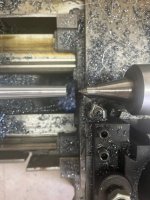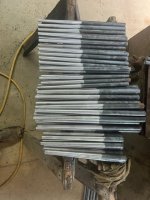Overland
Stainless
- Joined
- Nov 19, 2017
- Location
- Greenville, SC
A guy has asked me for 25 long tapered pins for use in timber frame work.
He wants a piece of 1" mild steel bar, with a taper 10" long, down to 3/8".
I have a taper attachment.
I'm thinking I can't avoid using tailstock support, but the photos he shows me don't show a center hole in the end. Maybe just cut off after.
Any other suggestions please ?
Bob
He wants a piece of 1" mild steel bar, with a taper 10" long, down to 3/8".
I have a taper attachment.
I'm thinking I can't avoid using tailstock support, but the photos he shows me don't show a center hole in the end. Maybe just cut off after.
Any other suggestions please ?
Bob





